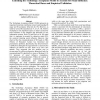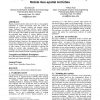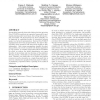33 search results - page 6 / 7 » A Collaborative Planning Model of Intentional Structure |
HICSS
1999
IEEE
13 years 11 months ago
1999
IEEE
The Technology Acceptance Model (TAM) represents an important theoretical contribution toward understanding IS usage and IS acceptance behaviors [6, 19]. However, as noted by seve...
IUI
2006
ACM
14 years 1 months ago
2006
ACM
Human geospatial activities often involves the use of geographic information in mobile environment where the context of technology use is dynamic, complex, and unstable, creating ...
UAI
2004
13 years 8 months ago
2004
Although many real-world stochastic planning problems are more naturally formulated by hybrid models with both discrete and continuous variables, current state-of-the-art methods ...
ATAL
2008
Springer
13 years 9 months ago
2008
Springer
Decentralized partially observable Markov decision processes (Dec-POMDPs) constitute an expressive framework for multiagent planning under uncertainty, but solving them is provabl...
AGENTS
2000
Springer
13 years 11 months ago
2000
Springer
This paper presents a knowledge approach to designing team training systems using intelligent agents. We envision a computer-based training system in which teams are trained by pu...



